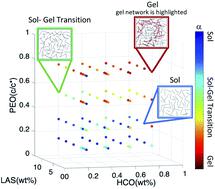Our official English website, www.x-mol.net, welcomes your
feedback! (Note: you will need to create a separate account there.)
Gelation phase diagrams of colloidal rod systems measured over a large composition space
RSC Advances ( IF 3.9 ) Pub Date : 2022-04-27 , DOI: 10.1039/d2ra00609j Shiqin He 1 , Marco Caggioni 2 , Seth Lindberg 2 , Kelly M Schultz 1
RSC Advances ( IF 3.9 ) Pub Date : 2022-04-27 , DOI: 10.1039/d2ra00609j Shiqin He 1 , Marco Caggioni 2 , Seth Lindberg 2 , Kelly M Schultz 1
Affiliation

|
Rheological modifiers tune product rheology with a small amount of material. To effectively use rheological modifiers, characterizing the rheology of the system at different compositions is crucial. Two colloidal rod system, hydrogenated castor oil and polyamide, are characterized in a formulation that includes a surfactant (linear alkylbenzene sulfonate) and a depletant (polyethylene oxide). We characterize both rod systems using multiple particle tracking microrheology (MPT) and bulk rheology and build phase diagrams over a large component composition space. In MPT, fluorescent particles are embedded in the sample and their Brownian motion is measured and related to rheological properties. From MPT, we determine that in both systems: (1) microstructure is not changed with increasing colloid concentration, (2) materials undergo a sol–gel transition as depletant concentration increases and (3) the microstructure changes but does not undergo a phase transition as surfactant concentration increases in the absence of depletant. When comparing MPT and bulk rheology results different trends are measured. Using bulk rheology we observe: (1) elasticity of both systems increase as colloid concentration increases and (2) the storage modulus does not change when PEO or LAS concentration is increased. The differences measured with MPT and bulk rheology are likely due to differences in sensitivity and measurement method. This work shows the utility of using both techniques together to fully characterize rheological properties over a large composition space. These gelation phase diagrams will provide a guide to determine the composition needed for desired rheological properties and eliminate trial-and-error experiments during product formulation.
中文翻译:

在大组成空间上测量的胶体棒系统的凝胶相图
流变改性剂用少量材料调节产品流变。为了有效地使用流变改性剂,表征系统在不同组成下的流变性是至关重要的。两种胶体棒系统,氢化蓖麻油和聚酰胺,其特征在于包含表面活性剂(直链烷基苯磺酸盐)和消耗剂(聚环氧乙烷)的配方。我们使用多粒子跟踪微流变学 (MPT) 和体流变学来表征这两个棒系统,并在大型组件组成空间上构建相图。在 MPT 中,荧光颗粒嵌入样品中,测量它们的布朗运动并与流变特性相关。根据 MPT,我们确定在两个系统中:(1)微观结构不会随着胶体浓度的增加而改变,(2) 随着耗尽剂浓度的增加,材料会发生溶胶-凝胶转变;(3) 在没有耗尽剂的情况下,随着表面活性剂浓度的增加,微观结构会发生变化,但不会发生相变。在比较 MPT 和整体流变结果时,测量到不同的趋势。使用体积流变学,我们观察到:(1)两种系统的弹性随着胶体浓度的增加而增加,(2)当 PEO 或 LAS 浓度增加时,储能模量不会改变。用 MPT 和体流变学测量的差异可能是由于灵敏度和测量方法的差异。这项工作显示了同时使用这两种技术来充分表征大组成空间的流变特性的实用性。
更新日期:2022-04-27
中文翻译:

在大组成空间上测量的胶体棒系统的凝胶相图
流变改性剂用少量材料调节产品流变。为了有效地使用流变改性剂,表征系统在不同组成下的流变性是至关重要的。两种胶体棒系统,氢化蓖麻油和聚酰胺,其特征在于包含表面活性剂(直链烷基苯磺酸盐)和消耗剂(聚环氧乙烷)的配方。我们使用多粒子跟踪微流变学 (MPT) 和体流变学来表征这两个棒系统,并在大型组件组成空间上构建相图。在 MPT 中,荧光颗粒嵌入样品中,测量它们的布朗运动并与流变特性相关。根据 MPT,我们确定在两个系统中:(1)微观结构不会随着胶体浓度的增加而改变,(2) 随着耗尽剂浓度的增加,材料会发生溶胶-凝胶转变;(3) 在没有耗尽剂的情况下,随着表面活性剂浓度的增加,微观结构会发生变化,但不会发生相变。在比较 MPT 和整体流变结果时,测量到不同的趋势。使用体积流变学,我们观察到:(1)两种系统的弹性随着胶体浓度的增加而增加,(2)当 PEO 或 LAS 浓度增加时,储能模量不会改变。用 MPT 和体流变学测量的差异可能是由于灵敏度和测量方法的差异。这项工作显示了同时使用这两种技术来充分表征大组成空间的流变特性的实用性。





















































 京公网安备 11010802027423号
京公网安备 11010802027423号